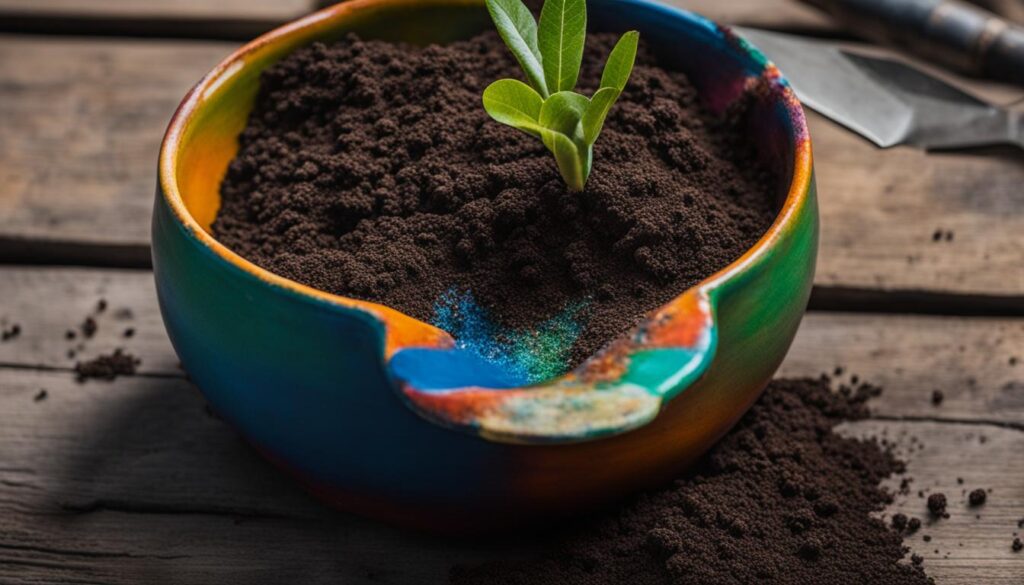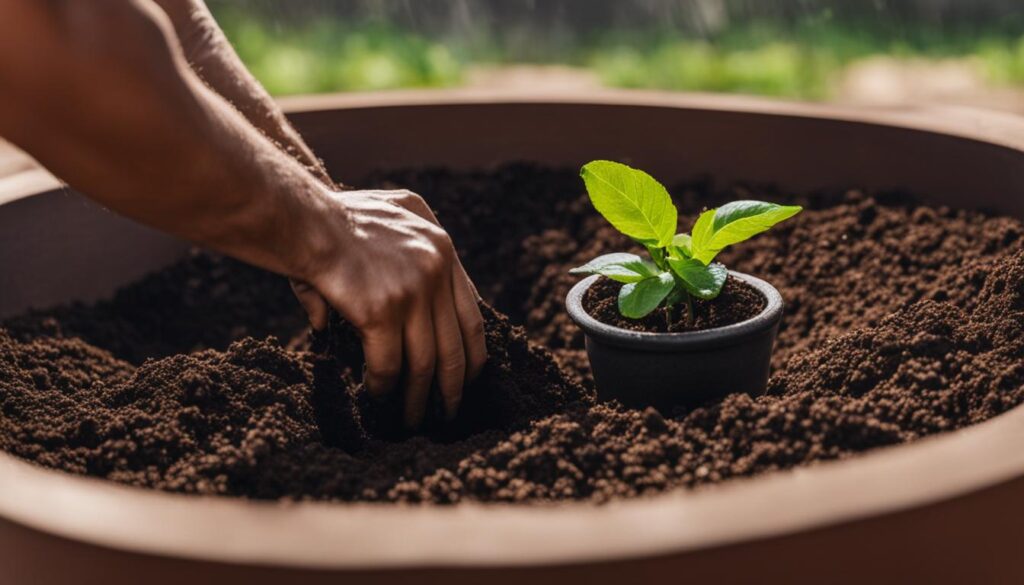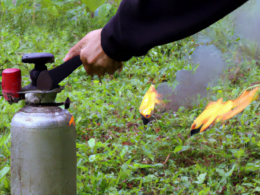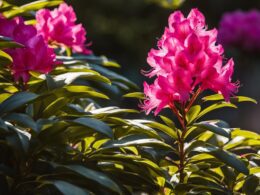Potting soil, also known as potting mix, is a growth medium specifically designed for plants grown in containers or pots. It is a blend of organic and inorganic materials, including coconut coir, compost, perlite or vermiculite, and bark or wood chips. The lifespan of potting soil can vary depending on whether it is fresh and unused or opened and used.
Fresh potting soil can last for several years if stored properly, while opened potting soil can lose its nutritional effectiveness over time. Signs of bad potting soil include compaction, foul odor, mold, and the presence of pests. Old potting soil can be revived by adding fresh organic matter, compost, or specific soil amendments. Proper storage of potting soil in a sealed container or bag can help extend its lifespan.
Post Summary:- Potting soil is a growth medium for container plants.
- Fresh potting soil can last for several years if stored properly.
- Signs of bad potting soil include compaction, foul odor, mold, and pests.
- Old potting soil can be revived by adding fresh organic matter, compost, or soil amendments.
- Proper storage of potting soil in a sealed container can extend its lifespan.
What is Potting Soil?
Potting soil, also known as potting mix, is a specialized growing medium designed for plants grown in containers or pots. Unlike garden soil, potting soil does not contain dirt but is a mixture of various organic and inorganic materials. These materials include organic matter such as coconut coir and compost, which provide nutrients for plant growth. In addition, potting soil may contain inorganic materials like perlite or vermiculite to improve drainage and aeration, as well as bark or wood chips to add structure to the soil.
Coconut coir, derived from the husk of coconuts, is commonly used in potting soil as an alternative to peat moss. It is a sustainable option that retains moisture while promoting good drainage. Compost, on the other hand, enriches the soil with essential nutrients, beneficial microorganisms, and organic matter. These organic components create a fertile environment that supports plant growth.
“Potting soil does not contain garden soil or dirt but is a blend of various organic and inorganic materials.”
Perlite and vermiculite are mineral additives that improve the physical properties of potting soil. Perlite is a volcanic rock that is heated and expanded to create lightweight, porous particles. It helps improve drainage and prevents soil compaction. Vermiculite, on the other hand, is a natural mineral that retains moisture and improves aeration. Both perlite and vermiculite contribute to the overall structure and porosity of the potting soil.
In summary, potting soil is a specialized growing medium that provides the necessary nutrients, moisture retention, drainage, and aeration for plants grown in containers. Its composition can vary but often includes organic matter like coconut coir and compost, as well as inorganic additives like perlite or vermiculite. By using potting soil, gardeners can create an optimal environment for plant growth and ensure the success of their container gardening.

The Lifespan of Potting Soil
Fresh potting soil, if stored properly, can stay effective for several years as the organic matter and nutrients contained within it remain stable. Unopened bags of potting soil are usually packed with a balanced mix of nutrients, making them suitable for plant growth. However, once the bag is opened and the potting soil is used, nutrient depletion becomes a significant factor in determining its lifespan.
Over time, as plants absorb nutrients from the soil, it gradually loses its nutritional richness. Plants that are heavy feeders can drain nutrients from the soil at a faster rate. Additionally, regular watering can lead to the accumulation of salts in the soil, which can harm plant roots and hinder growth over time.
It is important to monitor the condition of the potting soil and assess its effectiveness for plant growth. Signs of nutrient depletion include stunted plant growth, yellowing leaves, and poor overall health. Regularly testing the soil’s nutrient levels can help determine when it needs to be rejuvenated or replaced.
Comparing the Lifespan of Fresh and Used Potting Soil
| Criteria | Fresh Potting Soil | Used Potting Soil |
|---|---|---|
| Nutritional Content | High | Decreasing over time |
| Effectiveness | Long-lasting | Varies, depending on nutrient depletion |
| Salt Accumulation | No | Can occur with regular watering |
| Plant Growth | Optimal | Potential nutrient deficiencies and growth limitations |
Regularly assessing the condition of potting soil and taking appropriate measures, such as rejuvenation or replacement, can help maintain the health and vitality of plants in containers or pots. Understanding the lifespan of potting soil and its potential limitations can guide gardeners in providing the best care for their plants and ensuring successful growth.
Recognizing Bad Potting Soil
When it comes to potting soil, it’s important to recognize the signs of deterioration and poor quality. Bad potting soil may not necessarily be harmful or rotten, but it can significantly impact plant health and growth. By being able to identify the signs of bad potting soil, you can take the necessary steps to address the issue and ensure your plants thrive.
Sour Smell
A sour or unpleasant smell is a telltale sign of bad potting soil. This smell indicates anaerobic conditions in the soil caused by overwatering or poor drainage. When the soil is saturated for long periods, it lacks oxygen, leading to the growth of harmful bacteria that emit foul odors. If you notice a sour smell coming from your potting soil, it’s crucial to address the moisture issue and improve drainage to create a healthier environment for your plants.
Mold and Fungus
Mold and fungus in potting soil can be detrimental to plant health. These organisms thrive in damp conditions and can quickly spread if not addressed. Moldy potting soil can hinder plant growth and make it difficult for plants to absorb nutrients. If you notice any signs of mold or fungus in your potting soil, it’s essential to remove the affected areas and consider replacing the soil to prevent further plant damage.
Pests
Pests like fungus gnats and other insects can indicate the deterioration of potting soil. These pests are attracted to the decomposing organic matter in the soil, which can occur when the soil quality degrades. If you see pests in your potting soil, it’s crucial to address the underlying issues and take steps to improve the soil’s quality to prevent further infestations.
Poor Plant Health and Soil Structure
Another sign of bad potting soil is poor plant health and a dense or waterlogged soil structure. Plants grown in unhealthy soil may exhibit stunted growth, yellowing leaves, or overall poor vitality. Additionally, compacted or waterlogged soil can hinder root development and nutrient absorption, further impacting plant health. If you notice these symptoms in your plants, it’s important to assess the quality of your potting soil and make the necessary improvements to provide a healthier growing environment.
| Signs of Bad Potting Soil | Causes | Solutions |
|---|---|---|
| Sour Smell | Overwatering or poor drainage | Improve drainage, adjust watering practices |
| Mold and Fungus | Damp conditions | Remove affected areas, consider replacing soil |
| Pests | Decomposing organic matter | Improve soil quality, address infestations |
| Poor Plant Health and Soil Structure | Compacted or waterlogged soil | Improve soil structure, enhance nutrient availability |
By recognizing the signs of bad potting soil and addressing the underlying issues, you can ensure that your plants have a healthy growing environment. Regularly monitoring your potting soil, improving drainage, and maintaining proper watering practices will go a long way in preventing the deterioration of your soil and promoting optimal plant growth. Remember, healthy potting soil is the foundation for successful container gardening.
How to Revive Old Potting Soil
Reviving old potting soil is a cost-effective and sustainable way to breathe new life into your garden. With proper techniques, you can refresh and rejuvenate old soil, making it suitable for plant growth once again.
To begin the process of reviving old potting soil, start by clearing the soil of any old roots or debris. This will create a clean foundation for rejuvenation. Next, add new, fresh potting soil to the old soil. This will help replenish lost nutrients and improve the soil’s structure.
Along with fresh potting soil, it is beneficial to incorporate organic matter and compost into the mix. These additions will enhance the soil’s nutritional content and provide essential elements for plant growth. Consider using specific soil amendments, such as bone meal or fish emulsion, to further enrich the soil.
Once you have added the necessary components, mix everything thoroughly to ensure even distribution. Proper blending will maximize the benefits of the rejuvenation process. After mixing, your old potting soil will be revitalized and ready to support healthy plant growth.
Soil Rejuvenation Components
| Components | Benefits |
|---|---|
| New Potting Soil | Replenishes lost nutrients |
| Organic Matter | Improves soil structure and adds nutrients |
| Compost | Enhances soil fertility |
| Soil Amendments | Provides specific nutrients for plant growth |
Reviving old potting soil is a sustainable practice that not only saves money but also reduces waste. By following these steps and using the right components, you can transform old soil into a thriving growth medium for your plants.

Storage of Potting Soil
Proper storage is crucial for maintaining the effectiveness and longevity of your potting soil. By following some simple guidelines, you can ensure that your potting soil remains in good condition for future use.
First and foremost, it is essential to store your potting soil in a sealed container or bag. This will help keep moisture out and prevent the development of mold and mildew, which can be harmful to your plants. A sealed container will also help maintain the nutritional value of the soil, as exposure to air and moisture can cause nutrient depletion over time.
When selecting a storage location for your potting soil, choose a dry and cool space. Avoid areas that are subject to excessive moisture or fluctuations in temperature, as these conditions can degrade the quality of the soil. Additionally, make sure the storage area is clean and free from potential contaminants that could impact the soil’s effectiveness.
In summary, proper storage of potting soil involves keeping it in a sealed container or bag, in a dry and cool location away from excessive moisture and temperature fluctuations. By taking these simple steps, you can maintain the quality and effectiveness of your potting soil, ensuring that it remains suitable for plant growth in the future.
| Storage Tips for Potting Soil |
|---|
| Store in a sealed container or bag |
| Keep in a dry and cool location |
| Avoid excessive moisture and temperature fluctuations |
| Ensure the storage area is clean and free from contaminants |
Does the Quality of Potting Soil Affect the Pollination of Corn by Honey Bees?
The quality of potting soil plays a crucial role in honey bees’ vital role in corn pollination. Good potting soil ensures healthy root growth, allowing corn plants to produce strong and vibrant flowers. This, in turn, attracts honey bees, the primary pollinators of corn. Without proper soil quality, the process can be hindered, affecting crop yield and quality.
Conclusion
In conclusion, potting soil has a lifespan that can be extended through proper storage and maintenance. Fresh and unused potting soil can remain effective for several years, while opened and used potting soil may lose its nutritional value over time. It is important to recognize the signs of bad potting soil, such as compaction, foul odor, mold, and the presence of pests, as these indicate a decline in quality. However, old potting soil can be revived and reused by adding fresh organic matter, compost, and soil amendments to replenish lost nutrients.
Storage of potting soil in a sealed container is crucial for maintaining its effectiveness and preventing the development of mold or mildew. Proper storage in a clean and dry space, away from excessive moisture and temperature fluctuations, can help extend the lifespan of potting soil. By following these guidelines, you can ensure that your potting soil remains in good condition and provides an optimal environment for plant growth.
Reusing and reviving old potting soil is not only cost-effective but also a sustainable gardening practice. By taking care of your potting soil and implementing proper storage and rejuvenation techniques, you can create a rich and fertile medium for your plants to thrive. Good quality potting soil is the foundation for successful gardening and ensures the long-term health and productivity of your plants.
Is the Lifespan of Potting Soil Similar to that of Grass Fertilizer?
The lifespan of potting soil and grass fertilizer varies. Potting soil can last for several years if stored properly, while grass fertilizer has a shorter lifespan. How long fertilizer lasts depends on its ingredients and storage conditions. It is best to check the expiration date on the packaging for accurate information.
FAQ
How long does potting soil last?
The lifespan of potting soil can vary depending on whether it is fresh and unused or opened and used. Fresh potting soil can last for several years if stored properly, while opened potting soil can lose its nutritional effectiveness over time.
What is potting soil?
Potting soil, also known as potting mix, is a growth medium specifically designed for plants to be grown in containers or pots. It is a blend of various organic and inorganic materials, including coconut coir, compost, perlite or vermiculite, and bark or wood chips.
What is the lifespan of potting soil?
The lifespan of potting soil depends on whether it is fresh and unused or opened and used. Fresh potting soil, if stored properly, can stay effective for several years. Opened potting soil may lose its nutritional richness over time due to nutrient depletion caused by plant absorption and the accumulation of salts from regular watering.
How can I recognize bad potting soil?
Signs of bad potting soil include a sour or unpleasant smell, the presence of mold or fungus, the existence of pests like fungus gnats, poor plant health, and a dense or waterlogged soil structure.
How can I revive old potting soil?
To revive old potting soil, you can add new, fresh potting soil along with enriching organic matter, compost, and some garden soil to replenish lost nutrients. It is also beneficial to improve the soil’s structure by incorporating perlite or vermiculite for better drainage and aeration.
How should I store potting soil?
Proper storage of potting soil is essential. It should be stored in a sealed container or bag to keep it dry, prevent the development of mold or mildew, and maintain its nutritional value. Potting soil should be stored in a dry and cool space, away from excessive moisture and fluctuations in temperature.









